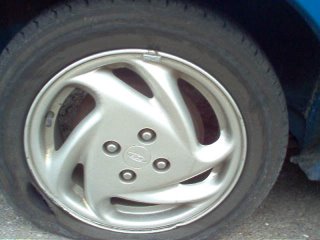Some thoughts on Wes Craven's New Nightmare
Personally, I find WCNN to be a magnum opus of a picture. Wes Craven returned to true form after making a string of critical and box failures, including Shocker and The People Under the Stairs. It is also important to bear in mind that WCNN was made before Scream, the film that put him back on the map from a box office standpoint. While WCNN was a box office failure, I believe this was the film that re-earned Wes a coveted spot as a "Master of Horror."
With WCNN, Craven uses his background in mythology to once again craft an ingenious story. Craven wants his audience to believe that Freddy Krueger is really a demon that has manifested itself in the form of the horror icon. With no NoES films in production, the demon has been released from the confines of celluloid and allowed to seep through into the real world. It's an extremely self-referential movie without having all the tongue-in-cheekiness of Scream.
As a first time viewing, the film is brilliant. Even the trailers for this were extremely misleading. They were very vague and hinted that something real or even documentary like was occurring. It ties in so beautifully with the original NoES, because it has that lucid, dreamlike quality to it. What's real? What's not?
The film opens on the production set of a movie. This movie appears to be a new Nightmare on Elm Street film (here on in referred to as NoES). Suddenly, the mechanical Freddy glove springs to life on its own accord and begins attacking crew members. Heather Lagenkamp then awakens from her nightmare. Craven demonstrates once again that he knows how to effectively manipulate an audience. The viewers are left in a very lucid and slightly disjointed state: the beginning was a dream? Is Heather Lagenkamp going to be Nancy or is she herself? We have, in essence, achieved exactly what Craven set out: we have entered a dream state of semi-awareness.
As if this wasn't enough to jolt us, an earthquake suddenly rips through. As a reminder of itself, it leaves cracks in the walls that suspiciously resemble claw marks. I have always viewed the earthquake in the beginning as the evil of the demon being unleashed. It is a very interesting concept that dreaming about Freddy, or in this case, the demon, is what gives him/it its power. Through Heather's dream, she is able to summon the demon into the real world. The claw marks in the wall help to support this. However, we as viewers aren't aware of this at this time. All we know is that it's an extremely foreboding warning that something bad is going to occur, we just aren't exactly sure what.
To further lend credibility to his script, Craven asked his cast members if he would be allowed to incorporate autobiographical elements into the script. We learn that Heather Lagenkamp is actually herself, which makes the audience feel like voyeurs intruding on her world. Heather really is married to a special effects artist in real life and she really did have a stalker. The stalker element will be used to chilling effect throughout the film, but I will save that for a little later.
Heather and her husband have a young son named Dylan. In a nice touch of dark humor, we are introduced to Dylan in pajamas. Heather chastises her son for playing with his food, and it's then we are garnered another hint that something is quite amiss. Dylan has formed a "Freddy face" in his cereal. Does Dylan know about his mom's movies? Is it merely a trick of the eye, a mere coincidence? Heather doesn't seem to notice it so why should we? Again, we are being manipulated as viewers. I believe that Dylan's "Freddy face" in the cereal again attests to the power of the demon. Demons are able to possess people, and we see this gradually happen to Dylan throughout the film. What is supposed to be harmless, normal activity for a child (playing with his food) instead is the signal of something evil.
Heather's husband leaves for the set of the latest movie he is working on. Heather feels reluctant about her husband leaving and even attempts to run after him. The phone rings, and she rushes to it, hoping it may be him. Instead, it is the voice of who Heather believes to be her stalker. Demons are also know for their abilities to possess knowledge about people. The demon would therefore have known about Heather's stalker. It decided to taunt her and terrify her, in effect, giving itself even more power. Perhaps the demon truly has been her stalker all along?
It's the tenth anniversary of the NoES series, and Heather is scheduled to reunite with Robert Englund on a talk show. Heather is very visibly nervous as Robert comes out not as himself, but as Freddy. Once she realizes it is him, she calms down and laughs, but there is still a lingering sense of tension about the whole scene. Perhaps my favorite shot in the whole film is when Robert as Freddy is waving his hands in the air to his adoring fans. There is a cult worship to him, and the demon thrives off it. It's also very crucifixion like: Robert has surrendered himself completely to Freddy, and in essence, to the demon.
Wes mentions on the audio commentary for NN that Robert himself is actually being possessed by this demon as well. That's why he paints the picture that looks a lot like our favorite claw wearing villian. This would make sense as to why his screen time is so limited, it's actually a brilliant twist in a way. The very thing that Robert has been on film is now literally trying to take over his life. Not only that, but it's clear that Wes was trying to present this as a mockumentary. In doing this, he needed to convince his audience that Robert Englund was just an actor and that this real demon was running around. If Englund would have had too much screen time, the audience would have been identifying him with Krueger. The film would probably not worked so well as a result.
Heather is informed that Wes wants to meet with her in regards to a new NoES film he is planning. Wes tells Heather that he needs her to play Nancy one last time. He says he has been having trouble sleeping and his insomnia has produced the script. Heather is confused by all of this and says she has to think it over.
Heather's husband falls asleep at the wheel on his way to race home after Heather informs him that her stalker has returned. He is slashed repeatedly by the very mechanical glove that Heather had dreamed about. Grief stricken, Heather turns to John Saxon, her father from the original NoES as a literal father figure. Dylan's behavior becomes increasingly strange, but everybody tries to chalk it up to grief over his father. In fact, everyone's behavior is being more and more erratic. The nurses suspect Heather is on drugs, Dylan is sleepwalking and Robert is becoming more and more consumed by Krueger. It's also a nice touch on how being known for one sole role can take a toll on a person after time.
Earthquakes begin appearing with more and more frequency, an indicator that the demon is near. Heather goes to open her closet and finds the demon in Freddy form. It attacks her and then whispers "Nancy" before disapearing. Heather than races to the hospital where Dylan has been committed to save him.
The climatic moment comes when Dylan has escaped from the hospital and has returned home. Heather frantically calls John and begs him to help her. While at her house, John refers to her as Nancy. Heather demands to know why John has called her Nancy, to which he replies "Why are you calling me John?" As he goes to get in his car, Heather finally realizes what she must do. She has to become Nancy. It is Nancy that recognizes the demon as the form it manifested in, and that is Freddy. It was Nancy that had the courage to turn her back from Freddy and yet it was Heather that had to have the courage to play Nancy. To give a name to something allows a person to have control over it. When the demon is lurking over Heather and saying "Nancy", this is exactly what he has done. It is Nancy he believes he has control over. Also, the moment Heather accepts being Nancy, the two souls are now fused together in a way. The demon believes it can claim two souls, so why wouldn't it wait for her acceptance?
With this acceptance, John has now morphed into Nancy's father. He tells her, "I love you pumpkin," to which she responds, "I love you too....daddy." With this, she is now clothed in pajamas and her house is now 1428 Elm Street. The demon arises from the bed, cocooned within sheets. It reveals itself as Freddy.
Heather/Nancy takes some sleeping pills that Dylan has left for her and enters the depths of the demon's hell. Snake imagery figures very prominently during these last scenes to great effect. Dylan's innocence, like those of Adam and Eve, has been lost at the hands of this demon. Heather/Nancy is able to slay the demon and things appear to return as they once were. Heather sees a script on the floor and flips to the end, "Heather, thanks for playing Nancy one last time-Wes."
I can understand why reaction to this was so hostile. By 1994, fans of NoES had expected a certain formula: Freddy would make some wise cracks and then dismember and kill his teenage targets in various clever ways. WCNN turned this formula on its heels. This was a very dark and serious film, perhaps even more so than the original NoES. Freddy as the demon still has his humor, but now it is chilling instead of being cheesy. The demon asks Dylan "Hey kid, ever play skin the cat?" as he drags Dylan's babysitter across the ceiling in a bloody fashion (which is also a nice homage to Tina's murder in NoES).
The appearance of Freddy also pissed off a lot of fans. This Freddy sports a claw that is actually fused into his hand, instead of being a metal glove. He also sports what has been dubbed "Gap Freddy" by the haters in that he wears a leather trench coat and long black boots. I am rather fond of this Freddy though, as the face is simply evil at its finest.
I think ultimately people were just confused. They weren't sure what this movie was attempting to be. I believe the downfall is how ahead of its time it was. Now, with films like Scream, there is a movie-within-a-movie awareness, but at the time of WCNN, this was unheard of.
It's not at all a strict sequel. Rather, it is Craven's omega to his alpha. It is his way of finally killing the very thing he created, and he did a brilliant job in doing so.



